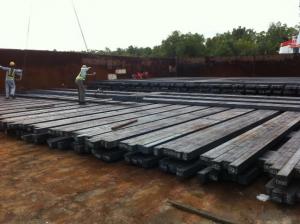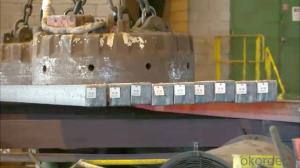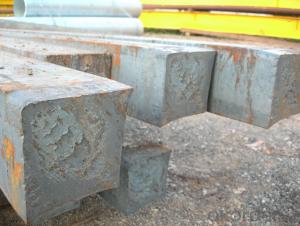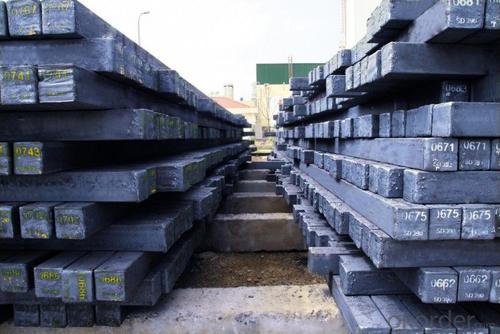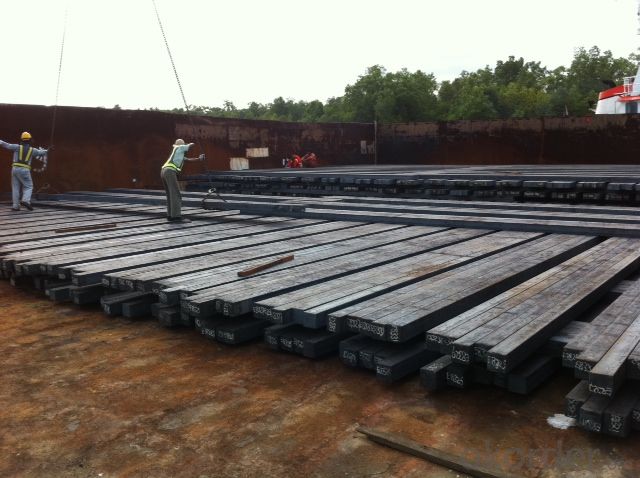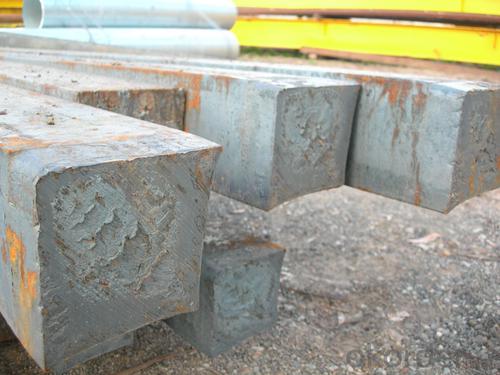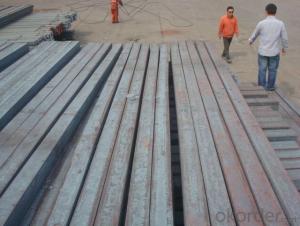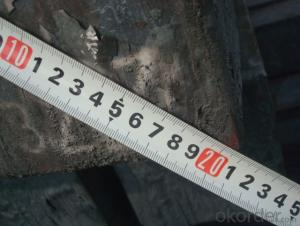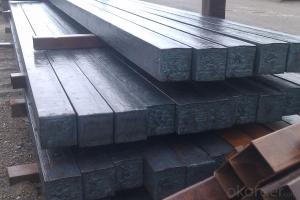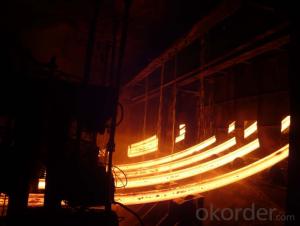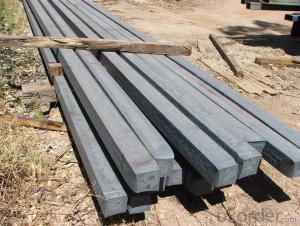Hot Rolled Square Steel Billet 3SP Standard 155mm
- Loading Port:
- Shanghai
- Payment Terms:
- TT OR LC
- Min Order Qty:
- 2000 m.t.
- Supply Capability:
- 10000 m.t./month
OKorder Service Pledge
OKorder Financial Service
You Might Also Like
Structure of Hot Rolled Square Steel Billet 3SP Standard 155mm

Description of Hot Rolled Square Steel Billet 3SP Standard 155mm
PPGI is made by cold rolled steel sheet and galvanized steel sheets as baseplate, through the surface pretreatment (degreasing, cleaning, chemical conversion processing), coated by the method of continuous coatings (roller coating method),
and after roasting and cooling. Zinc coating: Z60, Z80, Z100, Z120, Z180, Z275, G30, G60, G90
Alu-zinc coating: AZ60, AZ80, AZ100, AZ120, AZ180, G30, G60, G90
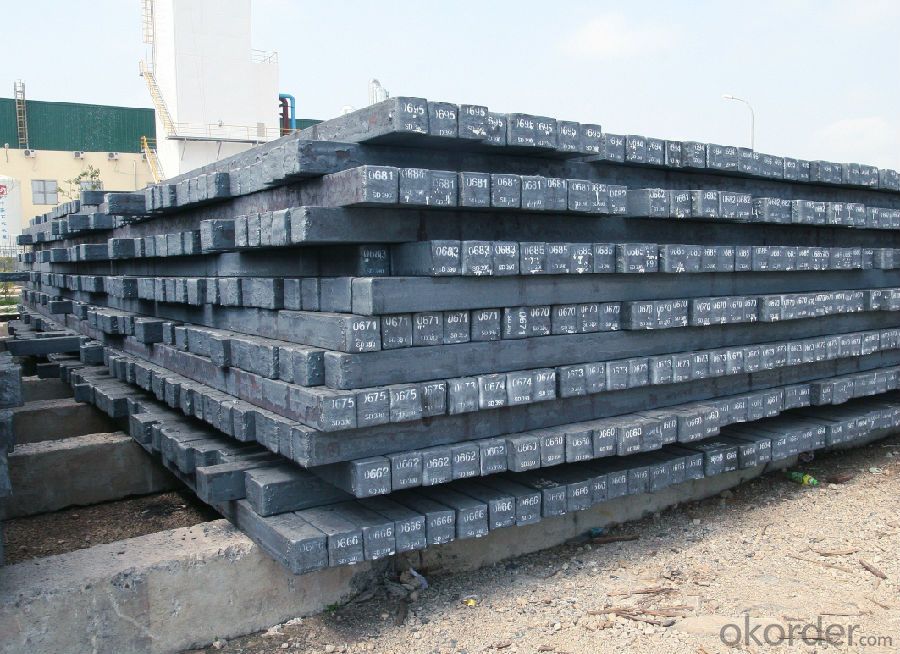
Main Feature of Hot Rolled Square Steel Billet 3SP Standard 155mm
1) Excellent corrosion resistance: The zinc layer provides a good protection of Pre-painted Galvanizeed Steel Sheet.
2) High heat resistance: The reflective surface of the material aids in efficiently reflecting the sunlight away and in turn reducing the amount of heat transmitted. The thermal reflectivity converts into energy savings.
3) Aesthetics: Pre-Painted Galvanized steel sheet is available in plethora of patterns and multiple sizes as per the requirements that given by our customers.
4) Versatility: can be used in the various areas.Standard seaworthy export packing: 3 layers of packing, inside is kraft paper, water plastic film is in the middle and outside GI steel sheet to be covered by steel strips with lock, with inner coil sleeve.
Applications of Hot Rolled Square Steel Billet 3SP Standard 155mm
1) Automotive bodies: filters, fuel tanks, etc.
2) Construction materials: roofings, welding pipes,
3) Electric and electronic appliances: computer cans, etc.
4) Steel cans: containers, etc.
5) Steel furniture: washing machines, refrigerators, microwaves, etc.
6) Drums
7) Office equipment: printer, recorders, etc.
8) Motors and transformers
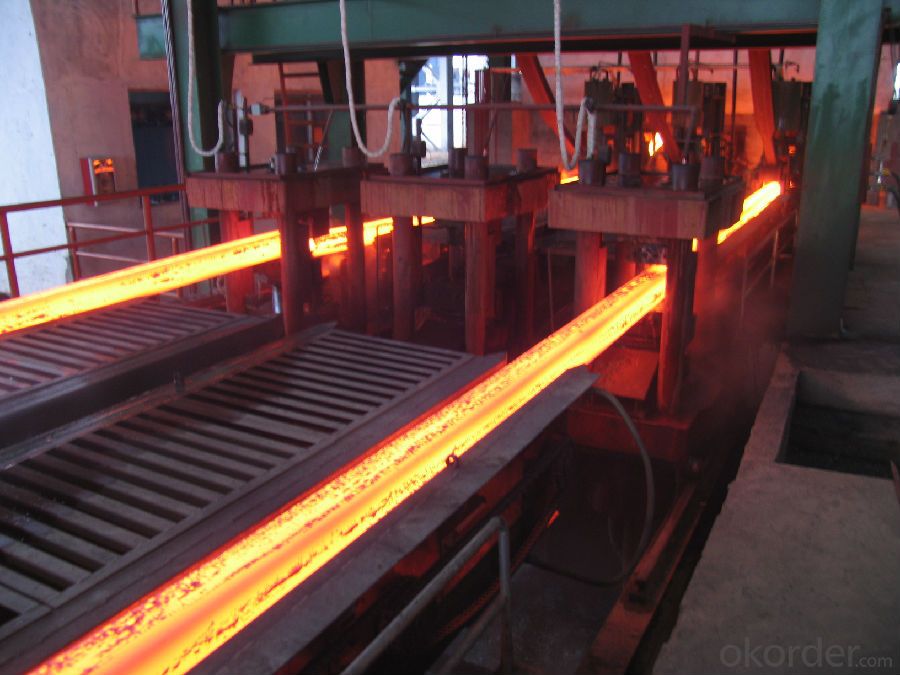
Specifications of Hot Rolled Square Steel Billet 3SP Standard 155mm
| Classified symbol | Yield Point Minimum N/mm2 | Tensile Strength Minimum | Elongation Minimum % | Application | ||||
| N/mm2 | Nominal Thickness mm (t) | |||||||
| JIS | Yogic | 0.25-0.4 | 0.4-0.6 | 0.6-1.0 | 1.0-1.6 | |||
| G3312 | specification | |||||||
| CGCC | CGCC | -205 | -270 | -20 | -21 | -24 | -24 | Commercial |
| CGCD | CGCD | --- | 270 | --- | 27 | 31 | 32 | Drawing |
| --- | CG340 | 245 | 340 | 20 | 20 | 20 | 20 | Structural |
| CGC400 | CG400 | 295 | 400 | 16 | 17 | 18 | 18 | Structural |
| CGC440 | CG440 | 335 | 440 | 14 | 15 | 16 | 18 | Structural |
| CGC490 | CG490 | 365 | 490 | 12 | 13 | 14 | 16 | Structural |
| CGC570 | CG570 | 560 | 570 | --- | --- | --- | --- | Structural |
| ASTM Designation | Yield Point Minimum | Tensile Strength Minimum | Elongation Minimum % | Application | Q/BQB 445-2004(China standard) | ASM A653/A653M | JISG 3312 | |
| ksi(MPa) | ksi(MPa) | TDC51D+Z | (CS TYPE A+Z) | CGCC | ||||
| A653(M)-99 CS TYPE A,B,C | --- | --- | --- | Commercial | TDC52D+Z | CGCD | ||
| A653(M)-99 FS | --- | --- | --- | Lock Forming | TS250GD+Z | (G250+Z) | - | |
| A653(M)-99 DS | --- | --- | --- | Drawing | TS300GS+Z | (G300+Z) | CGC 400 | |
| A653(M)-99 SS Grade33(230) | 33(230) | 45(310) | 20 | Structural | TS350GD+Z | (G350+Z) | CGC490 | |
| A653(M)-99 SS Grade37(255) | 37(255) | 52(360) | 18 | Structural | TS550GD+Z | (G550+Z) | CGC570 | |
| A653(M)-99 SS Grade40(275) | 40(275) | 55(380) | 16 | Structural | ||||
| A653(M)-99 SS Grade50(345) | 50(345) | 65(450) | 12 | Structural | ||||
| A653(M)-99 SS Grade80(550) | 80(550) | 82(570) | --- | Structural | ||||
FAQ of Hot Rolled Square Steel Billet 3SP Standard 155mm
We have organized several common questions for our clients,may help you sincerely:
1. How Can I Visit There?
Our company is located in Tianjin City, China, near Beijing. You can fly to Tianjin Airport Directly. All our clients, from home or aboard, are warmly welcome to visit us!
2. How Can I Get Some Sample?
We are honored to offer you sample.
3. Why choose CNBM?
1, ISO, BV, CE, SGS approved.
2, Competitive price and quality.
3, Efficient service team online for 24 hours.
4, Smooth production ability(50000tons/month) .
5, quick delivery and standard exporting package.
6, Flexible payment with T/T, L/C, Paypal, Kunlun bank, etc.
- Q: Are steel billets used in the manufacturing of construction machinery?
- Yes, steel billets are commonly used in the manufacturing of construction machinery. Steel billets are semi-finished products that are used as raw materials in various industries, including construction machinery manufacturing. These billets are typically made from molten steel that is cast into a solid form and then further processed to shape and size. Due to their high strength, durability, and versatility, steel billets are ideal for constructing heavy-duty components and structures in construction machinery. They can be used to manufacture various parts such as chassis, frames, buckets, booms, and arms, among others. The use of steel billets ensures that construction machinery is capable of withstanding the demanding conditions and heavy loads commonly encountered in construction projects.
- Q: What are the main challenges in steel billet production?
- Manufacturers and producers face several key challenges in the production of steel billets. One of the primary hurdles is the need to guarantee a consistent and uniform quality for the billets. These semi-finished products are further processed into various steel items, and any irregularities or variations in their quality can lead to defects or failures in the final products. Consequently, it is crucial to maintain strict quality control measures throughout the production process. Another significant challenge revolves around optimizing the production process to meet desired quantity and quality targets while minimizing costs. This entails efficiently utilizing resources such as raw materials, energy, and labor. Additionally, striking a balance between production speed and quality can be challenging, as increasing the speed may result in reduced quality or increased defects. Ensuring the safety of workers and the environment also poses a major challenge in steel billet production. The production process involves heavy machinery, high temperatures, and potentially hazardous materials, which can jeopardize the health and safety of workers. To address this, it is imperative to implement proper safety protocols, provide training, and ensure compliance with regulatory standards. Furthermore, meeting the constantly growing demand for steel billets presents a challenge for producers. Market demand fluctuates, necessitating the ability to adjust production capacity accordingly. This requires flexibility in production planning and efficient inventory management to avoid overproduction or stock shortages. Lastly, technological advancements and innovations within the steel industry bring both challenges and opportunities. Incorporating new technologies, such as automation, artificial intelligence, and data analytics, can enhance efficiency and productivity. However, integrating these technologies into existing production processes can be complex and often requires substantial investments and expertise. In summary, the primary challenges in steel billet production include maintaining consistent quality, optimizing production processes, ensuring safety, meeting market demand, and adapting to technological advancements. Overcoming these challenges necessitates continuous improvement, innovation, and a proactive approach to remain competitive in the steel industry.
- Q: How are steel billets used in the manufacturing of oil and gas components?
- Steel billets are used in the manufacturing of oil and gas components as they serve as the raw material for various parts such as pipes, valves, flanges, and fittings. These billets are heated and then shaped through processes like extrusion, forging, or rolling to create the desired component. The strength, durability, and resistance to corrosion of steel make it an ideal material for oil and gas applications, ensuring the reliability and safety of the components used in the industry.
- Q: Can steel billets be welded together?
- Yes, steel billets can be welded together. Welding is a common method used to join steel billets by heating the surfaces to a molten state and then allowing them to cool and solidify, resulting in a strong and continuous joint.
- Q: How are steel billets used in the manufacturing of industrial valves?
- Steel billets are used in the manufacturing of industrial valves as they serve as the raw material for forging and shaping various valve components, such as the body, bonnet, and stem. These billets are heated, and through a process called hot forging, they are transformed into the desired shape and size of the valve parts. The use of steel billets ensures the strength, durability, and integrity of the valves, making them suitable for demanding industrial applications.
- Q: What is the typical surface finish of a steel billet?
- Depending on the specific application and processing method, the surface finish of a steel billet can vary. Generally, steel billets are produced with a rough surface finish that may have imperfections like scale, oxide layers, or minor irregularities. This is primarily because of the manufacturing process involving hot rolling or casting. Hot rolling is a common method for producing steel billets. In this process, the steel is heated to high temperatures and shaped by passing it through rollers. This high-temperature process can result in the formation of scale or oxide layers on the billet's surface, making it appear rough and textured. Similarly, steel billets produced through casting methods like continuous casting or ingot casting may also have a rough surface finish. During these processes, the molten steel solidifies in molds, leading to surface imperfections like cracks, pits, or unevenness. However, it's important to note that the surface finish of steel billets can be improved through additional processes such as descaling, shot blasting, or grinding. These processes help remove scale, oxide layers, or other imperfections, resulting in a smoother and more uniform surface finish. Furthermore, steel billets intended for specific applications like precision machining or forging may undergo additional surface treatments like polishing or coating to achieve the desired finish. In conclusion, the typical surface finish of a steel billet is rough and may have scale, oxide layers, or minor irregularities. However, various additional processes can be used to improve the surface finish according to specific requirements and applications.
- Q: What are the environmental impacts of manufacturing steel billets?
- The manufacturing of steel billets has several environmental impacts. The process involves significant energy consumption, which often relies on non-renewable sources, leading to high greenhouse gas emissions. Additionally, the extraction and processing of raw materials, such as iron ore and coal, can cause habitat destruction, deforestation, and water pollution. Furthermore, the production of steel billets generates waste and byproducts, including slag and dust, which can have detrimental effects on air and water quality if not properly managed. Overall, the manufacturing of steel billets has notable environmental implications that need to be addressed through sustainable practices and technological advancements.
- Q: What are the physical properties of steel billets?
- Steel billets possess various physical properties that render them highly suitable for a multitude of industrial applications. Primarily, they exhibit a remarkable strength-to-weight ratio, ensuring impeccable structural integrity and the ability to endure heavy loads without deformation or breakage. Another significant physical attribute of steel billets lies in their hardness. Steel is renowned for its hardness, which grants it resistance against wear and tear. Consequently, steel billets prove to be ideal for sectors where durability and long-term performance are of utmost importance, such as construction, automotive, and machinery industries. Furthermore, steel billets boast a lofty melting point, enabling them to withstand extreme heat without deformation or liquefaction. This trait proves indispensable in applications involving high temperatures, such as the manufacturing of tools, machinery, and equipment within the aerospace and energy sectors. Additionally, steel billets exhibit exceptional ductility and malleability, facilitating their effortless manipulation into diverse structures and products. This adaptability makes steel billets highly versatile and amenable to various manufacturing processes, including rolling, forging, and extrusion. Moreover, steel billets demonstrate commendable electrical and thermal conductivity, rendering them suitable for applications that necessitate efficient heat transfer and electrical conduction. These properties hold particular value in the production of electrical wiring, power transmission lines, and heat transfer equipment. In conclusion, steel billets possess key physical properties encompassing high strength, hardness, melting point, ductility, malleability, and conductivity. These attributes enable their utilization across a wide range of industries and applications, where their exceptional performance and reliability are indispensable.
- Q: What is the role of steel billets in the manufacturing of automotive transmission systems?
- Steel billets play a crucial role in the manufacturing of automotive transmission systems as they are the starting material for forging various components such as gears, shafts, and other critical parts. The billets are heated and then shaped through the forging process to achieve the desired dimensions and strength required for these transmission components. The use of steel billets ensures the durability, reliability, and overall performance of automotive transmission systems in vehicles.
- Q: How are steel billets used in the manufacturing of power transmission towers?
- Steel billets are an integral component in the manufacturing of power transmission towers. These towers, which are used to support electrical power lines, require a strong and durable material to withstand the weight and stress of the overhead cables. Steel billets, which are essentially semi-finished steel products, serve as the raw material for the fabrication of power transmission towers. The billets are typically made of high-quality steel, which possesses excellent strength and structural properties. The manufacturing process begins with the selection and preparation of steel billets. These billets are heated to a specific temperature, known as the forging temperature, in a furnace. Once the billets reach the desired temperature, they are transferred to a rolling mill, where they are shaped and formed into the required sections for the power transmission towers. Using various rolling techniques, the heated steel billets are transformed into long, slender sections known as angles, channels, or I-beams. These sections are carefully crafted to provide the necessary structural integrity and load-bearing capacity required for power transmission towers. Once the steel sections are formed, they undergo further processes such as cutting, drilling, and welding to create the tower's components. These components include the legs, braces, cross arms, and other reinforcements that make up the tower structure. The steel billets used in the manufacturing of power transmission towers are crucial for ensuring the towers' strength, stability, and longevity. Steel's high strength-to-weight ratio makes it an ideal material for supporting the weight of the cables and withstanding external forces such as wind and ice loads. Additionally, steel's resilience and durability make it capable of withstanding harsh environmental conditions, including extreme temperatures and corrosive elements. In conclusion, steel billets are a fundamental material used in the manufacturing of power transmission towers. Through a series of heating, rolling, and fabrication processes, these billets are transformed into the various structural sections and components that make up the towers. The use of steel ensures that the power transmission towers possess the necessary strength, stability, and resilience to support the electrical power lines effectively.
Send your message to us
Hot Rolled Square Steel Billet 3SP Standard 155mm
- Loading Port:
- Shanghai
- Payment Terms:
- TT OR LC
- Min Order Qty:
- 2000 m.t.
- Supply Capability:
- 10000 m.t./month
OKorder Service Pledge
OKorder Financial Service
Similar products
Hot products
Hot Searches
Related keywords



